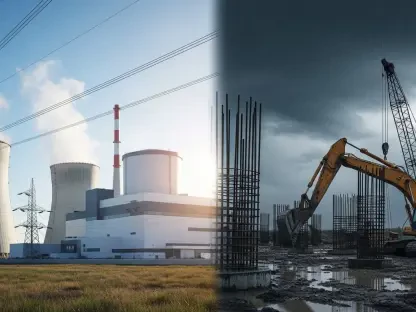US President Donald Trump has initiated a controversial campaign aimed at revitalizing the ailing coal sector through a series of executive orders. This ambitious program, designed to overturn previous regulations, has been met with significant debate regarding its potential impact on emission reduction efforts and public health. As the global trend continues to lean towards cleaner energy sources, experts are questioning the feasibility and long-term consequences of Trump’s coal-focused energy policy. This article examines the key aspects of Trump’s drive to resuscitate coal, the implications of his executive orders, the global movement away from coal, contrasting policies with Biden’s administration, various reactions, and the broader energy market trends.
Trump’s Drive to Revive Coal
The Trump administration’s efforts to revive the coal industry surface during a period of marked decline for coal both in the United States and worldwide. Coal, notorious as one of the dirtiest fossil fuels, plays a substantial role in carbon emissions and severe air pollution. President Trump has signed four executive orders aimed at overturning previous regulations intended to reduce greenhouse gases and encouraging relaxed policies against excessive carbon emissions. The White House asserts that these measures will rejuvenate the struggling coal sector.
During a public address to coal miners, Trump emphasized coal’s significance, labeling it “beautiful” and “clean” while championing its role in meeting burgeoning electrical demands. The executive orders aim to rapidly expedite leases for coal mining on federal lands and streamline the permitting process. Coal is portrayed as abundant, cost-effective, and essential for the nation’s energy needs. These orders also call for federal agencies to identify and eliminate any policy obstacles inhibiting investment in coal infrastructure and coal-fired electricity generation. However, the administration’s narrative neglects the critical environmental aspects of coal usage, such as its substantial contribution to carbon emissions and global temperature rise.
Executive Orders and Their Impact
The executive orders signed by President Trump are a pivotal part of his strategy to fast-track coal mining initiatives. Fundamentally, these directives encourage government agencies to discard policies obstructing coal infrastructure investments and generation activities. While Trump’s rhetoric highlights coal’s alleged benefits, the orders fail to address the adverse environmental impacts associated with coal consumption, such as its significant role in global warming and air pollution. Coal remains the largest source of fossil fuel carbon emissions and continues to contribute notably to the rise in global average temperatures.
This omission has provoked widespread concern, as the executive orders seemingly disregard coal’s substantial involvement in carbon emissions and its detrimental effects on air quality and public health. By overlooking vital environmental considerations, this move potentially undermines the previous administration’s emission reduction efforts and poses a significant threat to public health. Critics view these orders as retrogressive measures in the broader context of environmental sustainability and carbon emission reduction battles.
Global Trend Away from Coal
Global energy trends starkly contrast with the Trump administration’s stance; many countries have been moving away from coal since the Paris Agreement in 2015. Over 60 countries have either scaled back or altogether abandoned plans for new coal-fired power plants. This transition includes significant coal consumers such as Turkey, Vietnam, and Japan, and nations like Germany, South Korea, and the UK, which have phased out coal entirely. The international shift toward sustainable energy alternatives underlines the increasing global awareness of coal’s environmental consequences and the growing embrace of renewable energy sources.
Despite Trump’s endeavors, the coal industry within the United States faces persistent challenges, evidencing its declining trajectory. During Trump’s first term, nearly 100 coal plants either shut down or announced closures. These closures reflect the broader movement toward renewable energy sources which are gaining dominance due to their cost-effectiveness and environmental benefits. As renewable energy becomes steadily more affordable and prominent, coal’s role in the global energy landscape continues to diminish.
Trump’s Policies vs. Biden’s Policies
Trump’s executive orders are in direct opposition to the regulations established by President Joe Biden, targeting policies aimed at reducing emissions and promoting sustainability. One remarkable aspect of these orders is the allowance for older coal-fired plants to continue operating, effectively circumventing regulations by the Environmental Protection Agency (EPA) meant to curb emissions of hazardous pollutants. Another executive order directs the Justice Department to limit the enforcement of state laws that regulate harmful energy production, such as California’s cap-and-trade system. These actions are justified by Trump’s administration as necessary steps to meet an increased electricity demand driven by technological advancements, such as the proliferation of data centers and the expansion of domestic manufacturing.
Furthermore, Trump’s policies involve withdrawing the US from international climate agreements and halting support for renewable energy endeavors. Such measures stand in stark contrast to Biden’s initiatives aimed at sustainability and emission reductions. The differences between the two administrations underscore the deep policy divide concerning domestic and global environmental priorities and the pathways to achieve energy security and sustainability.
Reactions and Consequences
The response to Trump’s executive orders has varied across different stakeholders. States with significant fossil fuel interests, such as Wyoming and West Virginia, have greeted the revival of their coal industries with enthusiasm. Wyoming officials, for instance, have dubbed coal as “the energy of the future” and celebrated Trump’s actions as promising for their local economy.
Conversely, environmental groups have strongly criticized Trump’s initiatives. They argue that coal is costly and harmful to public health and the environment, leading to both increased electricity prices and pollution. The Sierra Club, among others, has highlighted the health risks associated with coal, emphasizing that continuing to operate coal plants could result in illnesses and premature deaths. They refer to studies indicating that coal-fired power plant pollution contributed to approximately 460,000 deaths between 1999 and 2020. Democratic Senator Ed Markey condemned Trump’s orders, underscoring the detrimental impact of increasing coal mining activities on public lands and the associated financial burdens on taxpayers.
Broader Energy Market Trends
Examining the broader US energy market reveals a marked decline in coal usage, with renewable energy sources gaining increasing prominence. In 2023, coal accounted for merely 10% of the US’s total energy supply. Industry experts argue that coal plants are becoming obsolete, uncompetitive, and unreliable compared to cleaner energy alternatives. Analysts, such as Kit Kennedy from the Natural Resources Defense Council, advocate for modernizing the energy grid and focusing on sustainable energy solutions rather than clinging to outdated technologies.
Efforts to modernize the energy infrastructure and advance renewable energy sources are believed to possess more considerable benefits for long-term sustainability. Critics view Trump’s adherence to coal as a retrogressive move that imposes costs on utility customers and deters investment in modern energy innovations. The shift towards renewable energy represents the reality of prevailing market trends and the continued decline of coal’s role.
Conclusion
US President Donald Trump has started a contentious initiative to revive the struggling coal industry through a series of executive orders. This ambitious plan seeks to dismantle prior regulations, sparking significant debate over its potential effects on emission reduction efforts and public health. While the global trend is shifting toward cleaner energy sources, experts are questioning the feasibility and long-term impact of Trump’s coal-centered energy policy. This article delves into the critical elements of Trump’s efforts to rejuvenate coal, the implications of his executive orders, the global shift away from coal, comparing policies with the Biden administration, various reactions, and wider trends in the energy market. As the world increasingly embraces renewable energy, the debate around Trump’s commitment to coal underscores the significant challenges and complexities of energy policy and environmental responsibility in the 21st century.









